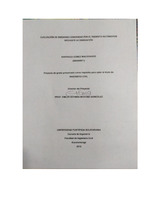Mostrar el registro sencillo del ítem
Evaluación de emisiones generadas por el tránsito automotor mediante la simulación
| dc.contributor.advisor | Moreno González, Emilio Germán | |
| dc.contributor.author | Gómez Maldonado, Santiago | |
| dc.coverage.temporal | 2020 | |
| dc.date.accessioned | 2021-08-18T22:23:43Z | |
| dc.date.available | 2021-08-18T22:23:43Z | |
| dc.date.issued | 2020 | |
| dc.identifier.uri | http://hdl.handle.net/20.500.11912/9030 | |
| dc.description | 79 páginas | spa |
| dc.description.abstract | El trabajo de investigación propone una metodología para cuantificar el efecto de la contaminación producida por el tránsito automotor que circula por un sector de la ciudad de Bucaramanga. La metodología permite reproducir modelos de pronóstico del comportamiento de las emisiones de gases generados mediante simulación aplicando el software Traffic Software Integrated System. Dichas emisiones afectan directamente la calidad del aire constituyendo un problema de salud pública que amerita una vigilancia constante, para realizar correcciones que sean propiciadas por el ente encargado del control del medio ambiente, y lograr de esta forma, cumplir metas que impulsen la reducción de tales efectos. De lo indagado en visita realizada a la CDMB como organismo encargado, se determina un único mecanismo de monitoreo de emisiones, es decir, estaciones localizadas en ciertos sectores, las cuales ya presentan disfuncionalidad debido a falta de recursos para mantenimiento. La selección del sector tiene en cuenta el monitoreo mediante estación de la CDMB que puede ser un referente de calibración usando los resultados obtenidos en futuros trabajos de validación que no están a nuestro alcance. El sector seleccionado corresponde a la calle de los estudiantes ubicada en La ciudadela, Real de minas, que presenta un sistema de red viaria cerrado lo que facilita el aforo de vehículos. El aforo vehicular en el sector representó un muestreo de 4 días en semana, en horarios comprendidos entre 6:00 y 9:00am, 11:00 y 2:00pm, y entre 5:00 y 7:00pm. El procedimiento consistió en digitar los datos provenientes del aforo vehicular en la red vial restituida dentro del software TSIS. Los resultados son organizados en Excel para obtener los modelos mediante el ajuste de las tendencias de los valores de comportamiento de cada tipo de emisión señalada y poder realizar la evaluación regresiva y progresiva en el tiempo del efecto de contaminación. | spa |
| dc.description.abstract | The research work proposes a methodology to quantify the effect of pollution caused by automobile traffic that circulates through a sector of the city of Bucaramanga. The methodology allows reproducing prognostic models of the behavior of the gas emissions generated by simulation by applying the Traffic Software Integrated System software. These transmissions directly affected the quality of the air constituting a public health problem that merits constant vigilance, to make corrections that are propitiated by the entity responsible for the control of the environment, and achieve in this way, meet goals that drive the reduction of stories effects. From what was investigated during a visit to the CDMB as the agency in charge, a single emission monitoring mechanism is determined, that is, stations located in certain sectors, which already have dysfunctionality due to lack of resources for maintenance. The sector selection takes into account monitoring using the CDMB station, which can be a calibration reference using the results selected in future validation work that are not within our reach. The selected sector corresponds to the street of the students located in La Ciudela, Real de Minas, which has a closed road network system which facilitates the capacity of vehicles. The vehicle capacity in the sector represents a sampling of 4 days a week, at times between 6:00 and 9:00 am, 11:00 and 2:00 pm, and between 5:00 and 7:00 pm. The procedure consisted of typing the data from the vehicle capacity in the red vial restored within the TSIS software. The results are organized in Excel to obtain the models by adjusting the trends of the behavior values of each type of emission indicated and to be able to perform the regressive and progressive evaluation in time of the effect of the contamination. | eng |
| dc.format.mimetype | application/pdf | |
| dc.language.iso | spa | |
| dc.publisher | Universidad Pontificia Bolivariana | spa |
| dc.rights | Attribution-NonCommercial-NoDerivatives 4.0 International | * |
| dc.rights.uri | http://creativecommons.org/licenses/by-nc-nd/4.0/ | * |
| dc.subject | Vehículos de motor | spa |
| dc.subject | Instituciones públicas - CDMB (Corporación Autónoma Regional para la Defensa de la Meseta de Bucaramanga) | spa |
| dc.subject | Software - Traffic | spa |
| dc.subject | Software - Integrated | spa |
| dc.subject | Software - System | spa |
| dc.subject | Emisiones de gases | spa |
| dc.subject | Medio ambiente | spa |
| dc.title | Evaluación de emisiones generadas por el tránsito automotor mediante la simulación | spa |
| dc.type | Trabajo de grado | spa |
| dc.publisher.department | Escuela de Ingenierías | spa |
| dc.publisher.program | Ingeniería Civil | spa |
| dc.type.hasVersion | publishedVersion | spa |
| dc.description.sectional | Bucaramanga | spa |
| dc.description.degreename | Ingeniero Civil | spa |
Ficheros en el ítem
Este ítem aparece en la(s) siguiente(s) colección(ones)
-
Trabajos de grado [6698]
Monografías, artículos, informes, proyecto de grado


